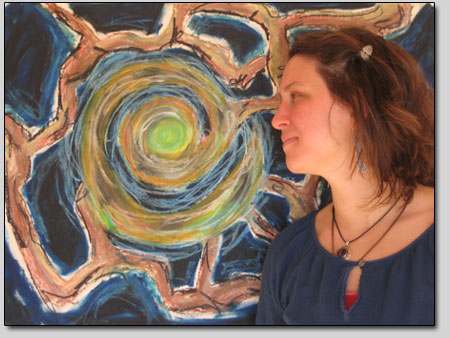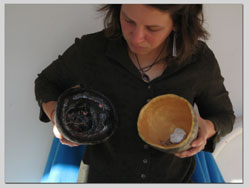|
| ||||
| One practitioner’s passion
by Jules Masterjohn Art, both as product and process, serves many varied roles in our culture. From creating beauty to provoking and confronting the viewer, art always serves to meet the needs of the artist. Art, too, can fulfill an even more intimate purpose – as a tool and technique for self-discovery and emotional healing. Though many artists have long understood these personal benefits of art making, the field of art therapy is proving that the creative process can be of great aid to the non-artist as well. For nearly half a century, the therapeutic potential of art making – using paint, clay, pastels, and collage-has been known. Through direct observation by artists working in psychiatric hospitals and rehab centers, it became clear that the creative process could be an effective communication tool between a patient and a therapist. From its early stages of development, art therapy has been used as a diagnostic tool. Certain kinds of images – a child’s drawing of its mother without a face, for instance – might indicate feelings of abandonment by the child. Or an adult’s drawing of herself that takes up only inches of a large sheet of paper, could suggest feelings of insignificance. The preponderance of one color or shape as well as repeated subject matter and scenarios might direct a therapist’s inquiries with a client. As the field has grown and incorporated various psychological modalities, so has its use. Today, art therapists work in many settings and in various of capacities, helping clients bring to light hidden emotional issues and unleash their creative potential, giving physical expression to innermost feelings. Art therapist Hannah Salander is passionate about this aspect of her field. The personal experience she has gained while using the creative process for her own deep discovery and inner reconciliation, fuels her enthusiasm. “Art has been an integral part of my own healing.” While enrolled in the masters program in Transpersonal Counseling at Naropa University in Boulder, she engaged in intensive art therapy as a client, as part of her academic study.
Salander shared her ceramic sculpture called, “Holding Polarity,” which she created in one of her studio art therapy classes. The sculpture is an open egg, one half is colored gold, representing the light, and the other half is painted black, representing the dark. She explained, “An egg has been born and opened, exposing both light and dark – great sadness and grief as well as hope and trust. Art therapy is about polarity. It is about bringing together duality and visualizing, through the art, our capacity to accept the range of emotion we experience as part of our humanness.” Of this particular piece, she asked herself, “What lives deep inside?” And the answer that grounds this sculpture and her art therapy practice, is, “It is our truth asking to be honored and trusted.” Often Salander has been moved by her clients’ revelations and the inner wisdom that expresses itself through their art. She remembers a young client who created an inside/outside box, a process that Salander finds especially rich for revealing deep insights. The outside represents how the world sees us, and the inside is how we view ourselves. “This young girl covered the outside of her box with sharp pieces of broken glass. On the inside was an unbroken piece of glass.” The girl believed that the world saw her as broken, yet she felt whole on the inside. “There is always more to the story, another layer. That is a sweet thing to behold, the sacredness of seeing oneself as whole.” The validity of one’s inner life – with its paradoxical thoughts and feelings – is the foundation of the art therapy process and is the basis of trust within the therapeutic relationship. Salander knows from her own therapy and has seen with her clients that the practice of creating the art is a metaphor for creating the life. Through the physical act of discovery, of making one’s feelings visible, she believes one can gain confidence and develop capacity to accept contradictory feelings as both being authentic and true. Within the principles of art therapy, the simple act of making – the creative process – is therapeutic. Additionally, the art object is seen as an extension of the self, bringing the process and the object together into a holistic understanding. So, a client may be encouraged to enter into a dialogue with the art object, asking it, “Where did you come from?” The art object may, also, become a springboard for a conversation between therapist and client. An art therapy session with Salander unfolds in many different ways, always directed by a client’s readiness to explore. One of Salander’s most powerful and revealing art explorations is titled, “The Source.” Made with oil sticks on paper, one of her favorite mediums, she chose to use the spiral-shaped drawing as the logo on her business cards. “It is the symbol of the universe at work, of trust. The branches hold and support this swirl. It is life, activity, emotion, relationship, birth and death. It is an image I come back to that describes my work as an art therapist – to support people in their own unfolding, their trusting in themselves, and in this mystery that we live.” •
|
In this week's issue...
- May 15, 2025
- End of the trail
Despite tariff pause, Colorado bike company can’t hang on through supply chain chaos
- May 8, 2025
- Shared pain
Dismal trend highlights need to cut usage in Upper Basin, too
- April 24, 2025
- A tale of two bills
Nuclear gets all the hype, but optimizing infrastructure will have bigger impact



